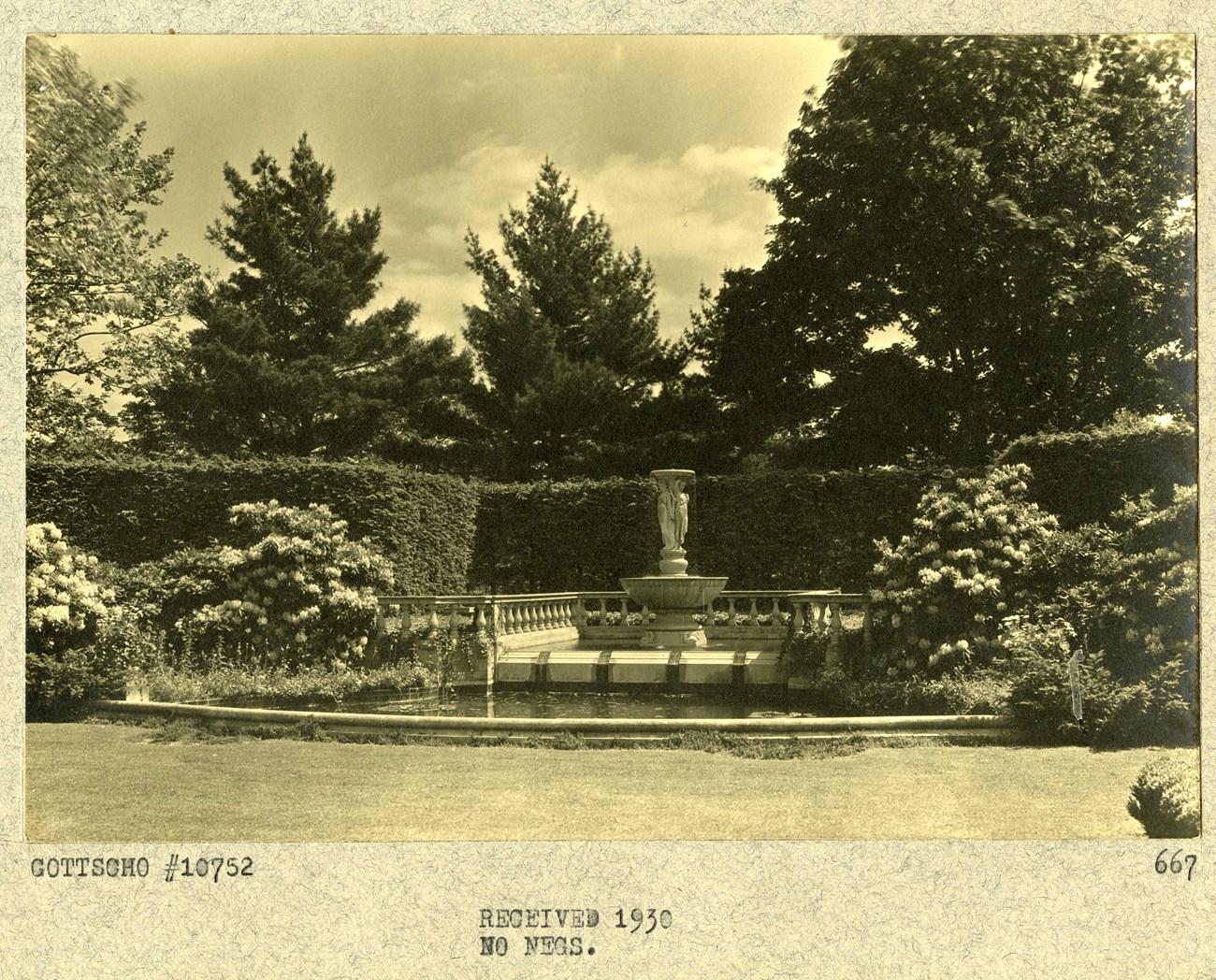
Photo #5578-667, cropped, 1930, Olmsted Archives In the early twentieth century, Olmsted Brothers received many commissions to design gardens for private estates. While Frederick Law Olmsted had worked on some private estates at the end of his career, this type of project grew significantly after his retirement in 1895. During that time period, country estates were growing in popularity and became one of the most common commissions for the firm from the 1900s to 1930s. Many wealthy individuals wanted their landscapes to be just as lavish as their homes. Olmsted Brothers designed different styles of gardens for estate owners, though they tried to work with the natural scenery of all spaces. For some estates, they incorporated their tradition of natural design to create open lawns and winding paths that were heavily planted. Many owners also wanted European-influenced formal gardens that corresponded to the architecture of their homes. These gardens were more decorative, with geometric lawns, flower beds, pools, and sculptures. For some gardens, Olmsted employees worked with sculptor Johan Selmer-Larsen to create decorative sculptures and other accents. Selmer-Larsen was a Norwegian-born artist whom the Olmsteds employed to help with modeling and sculpting. He first took up work for Olmsted Brothers in 1912 and produced pieces for the firm for over forty years. This page shows some of the pieces Selmer-Larsen designed for three estates. Some of these sculptures were meant as statements, others as small details that we might otherwise overlook. From these images, we can better understand the design process and watch Selmer-Larsen's ideas turn into finished products. The photos also reveal the craftsmanship behind each sculpture.

Photo #00529-137, cropped, 1934, Olmsted Archives Who was Johan Selmer-Larsen?Johan Selmer-Larsen was born in 1876 in Sarpsborg, Norway. At the age of 17 he left for the United States, where he found employment with an uncle and trained as an artist in his spare time. After ten years, he returned to Norway and worked as a sculptor and painter. However, he decided his future lay in the United States. Selmer-Larsen returned to America in 1906, settling in Boston. After a few years gaining commissions around the area, he was hired by the Olmsteds in 1912. In 1918 he sold his own studio and set up shop in the Olmsted's barn. He worked for Olmsted Brothers for over forty years, creating many pieces of architectural sculpture for gardens and institutions in his classical style. He also taught at the School of the Worcester Art Museum and was Instructor in Modelling at the Architectural School at MIT. By 1918 Selmer-Larsen was living full time in Marblehead, MA, with his wife Margrethe and, eventually, four children. The coastal scenery of Marblehead inspired him in his artwork and reminded him of his home in Norway. With other local artists in the area he founded the Marblehead Arts Association, which continues to this day. He also gained local acclaim as a skilled designer and constructor of model yachts. Selmer-Larsen continued to stay active as an artist through the late 1950s. He passed away in 1967 at the age of 91. 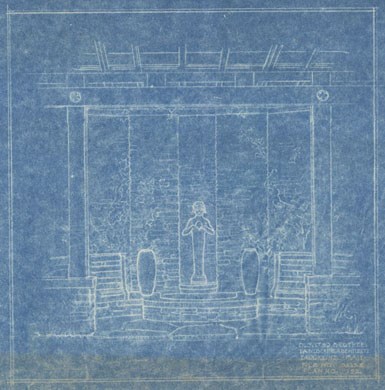
Plan #03223-C-152-pt1, Olmsted Archives Woodward EstateGeorge and Gertrude Woodward set up their home "Krisheim" near Philadelphia, PA. Their house was in an English Tudor style designed by the architecture firm Peabody and Stearns. For the grounds, they hired Olmsted Brothers to design the landscape and a terraced garden for Krisheim.
Boy Fountain
One of the features of Krisheim's garden was a fountain of a boy nestled into a niche (see blueprint of the plan to the right). During the summer of 1912, Johan Selmer-Larsen carved a model of the figure, shown below. Notice how he refined features such as the hair between the unfinished and finished version of the model.
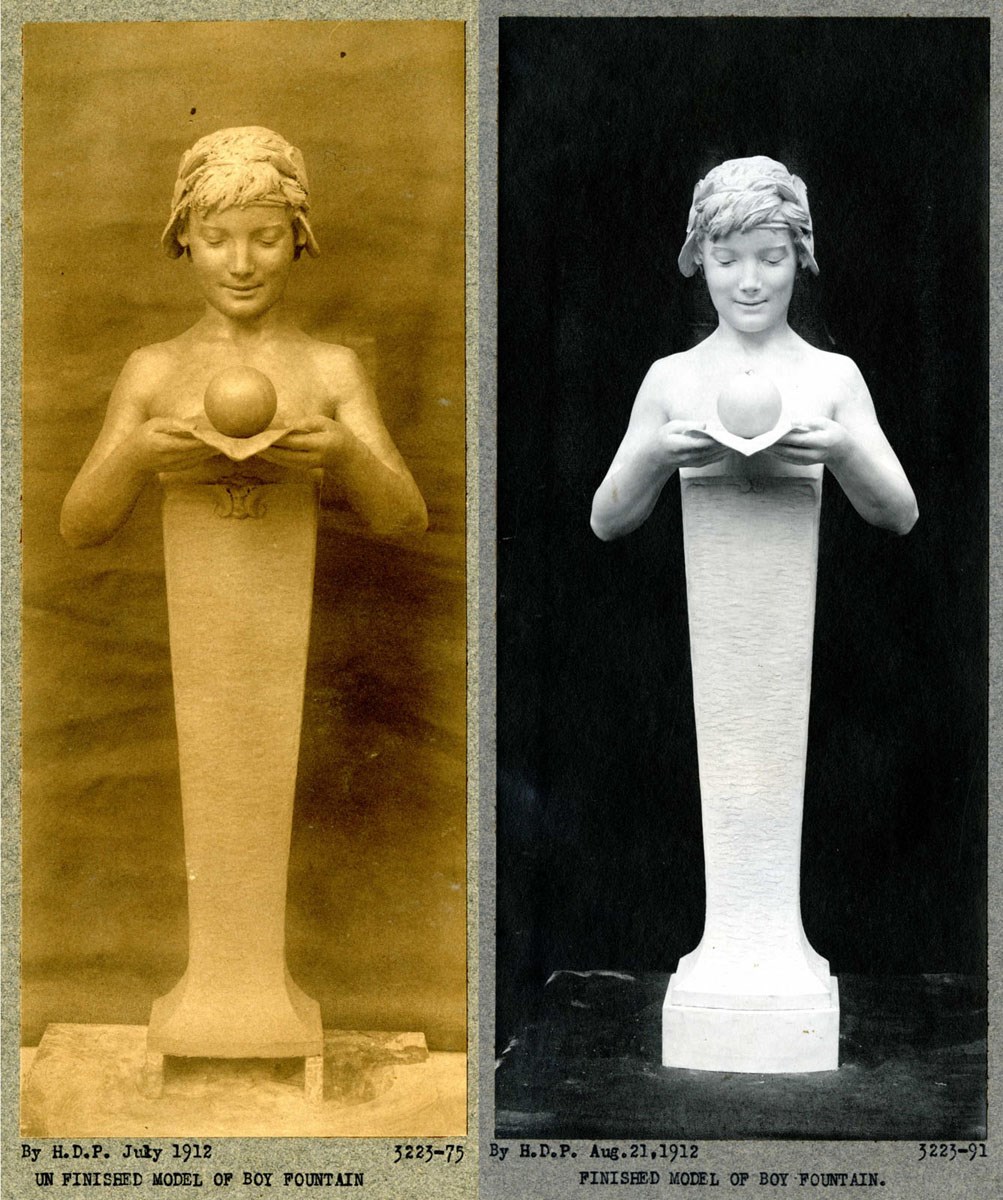
Olmsted Archives Next, the model was cast and placed into the terrace. The Woodwards could sit on the benches on either side and enjoy the fountain. 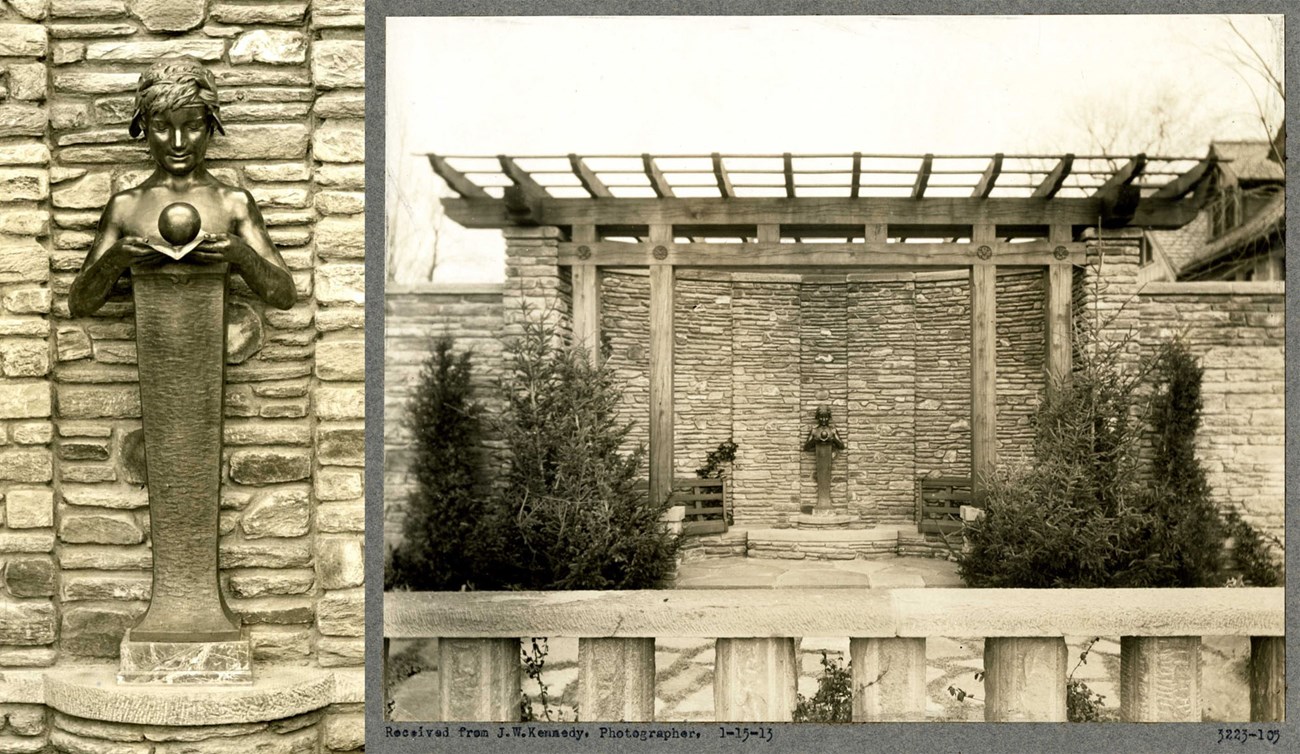
Left: Photo #3223-104, cropped, 1913; Right: Photo #3223-105, 1913, Olmsted Archives Krisheim Bench Before he began to sculpt, Selmer-Larsen often planned out his ideas in sketches. In this case, he drew several different versions of his ideas for the back of a garden bench. All designs incorporated a poem about Krisheim, but the details and compositions differed.

Plan #3223-169-pa1, Olmsted Archives Another plan shows the design of the bench, as well as the final version engraved by Selmer-Larsen. How did he illustrate the poem through his design? 
Plan #3223-172-A, 1915, Olmsted Archives 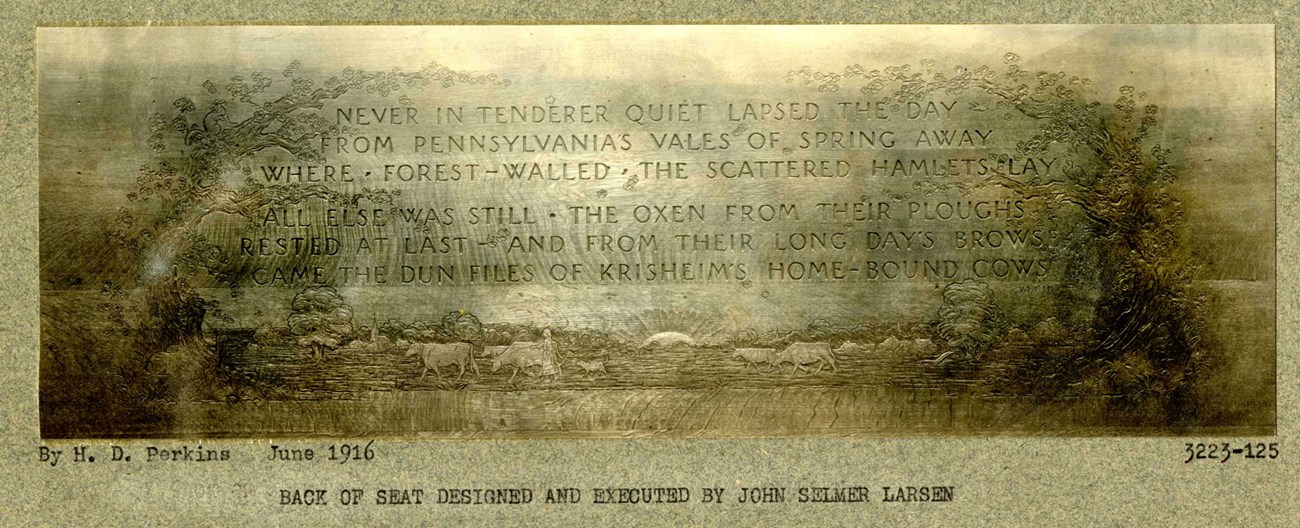
Photo #3223-125, 1916, Olmsted Archives 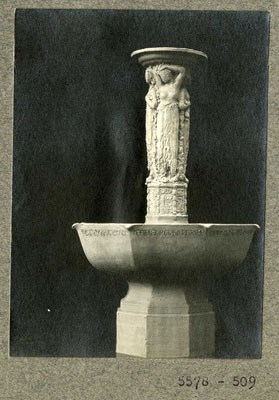
Photo #5578-509, Olmsted Archives Aldred Estate
Fountain of the Three Graces These photos depict Selmer-Larsen's developing ideas for a fountain. He considered different designs for the bases and the arrangement of the three graces. The image shows what was most likely the last model. What similarities and differences do you see in each of his designs? 
Job #5578, Olmsted Archives
After working out his final design, Selmer-Larsen created a mold of the full-size sculpture. 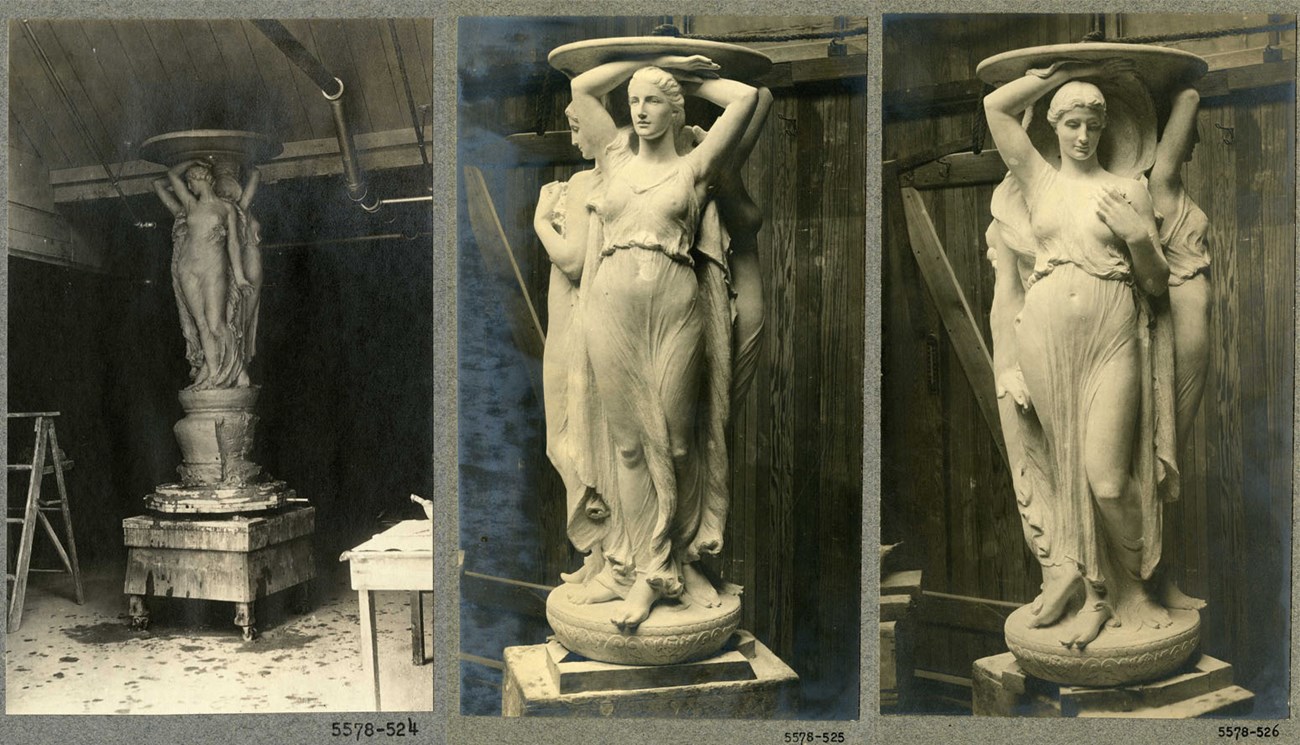
Job #5578, Photos 524, 525, & 526, Olmsted Archives 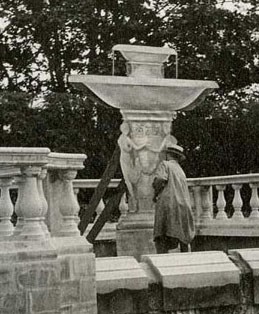
Photo #5578-284, cropped, 1917, Olmsted Archives The final product is a beautiful fountain nestled into a beautiful setting.
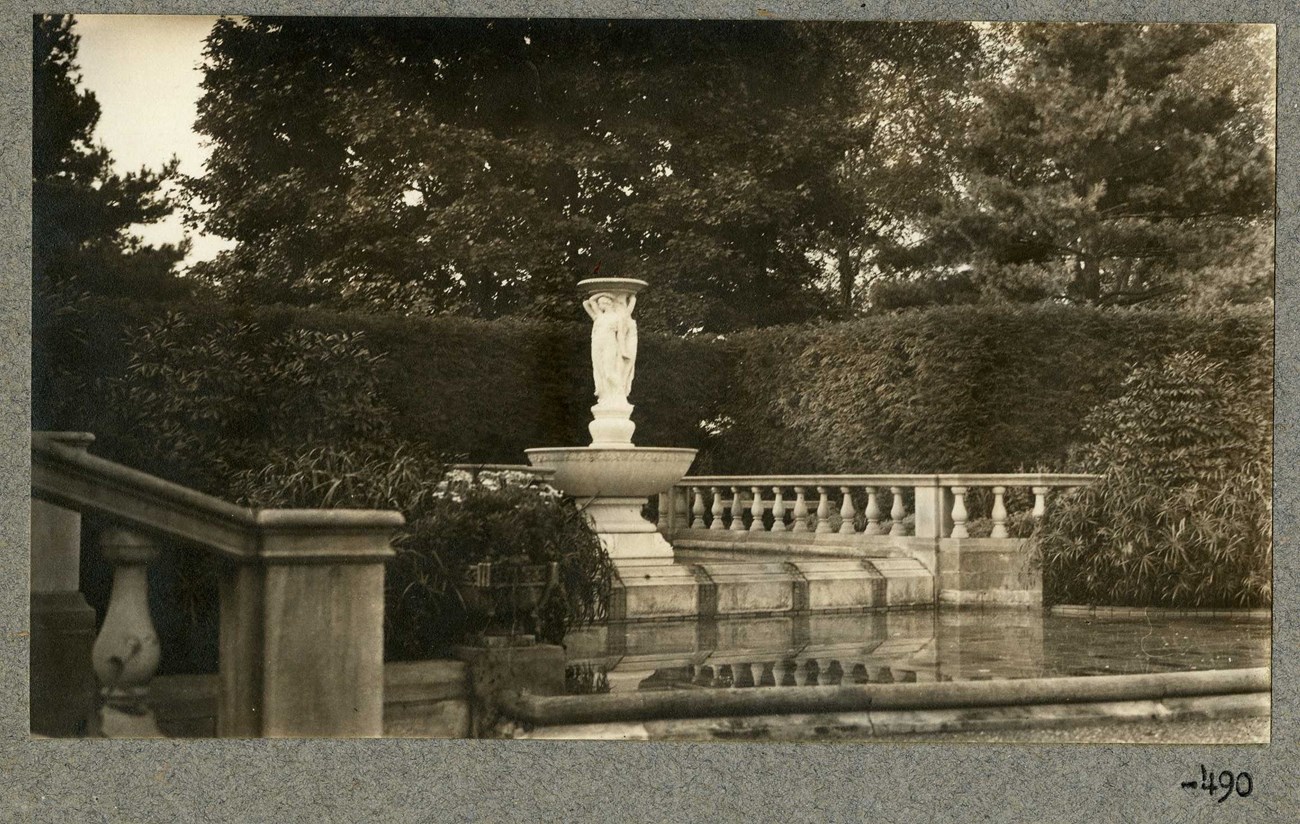
Photo #5578-490, Olmsted Archives 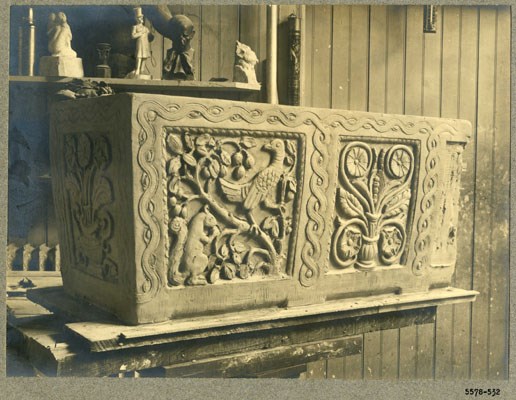
Photo #5578-532, Olmsted Archives Flower Boxes Selmer-Larsen also designed several flower boxes for the Aldred estate. Many of them incorporated stylized natural imagery. Below is a flower box model in the shop and the finished version in the garden. 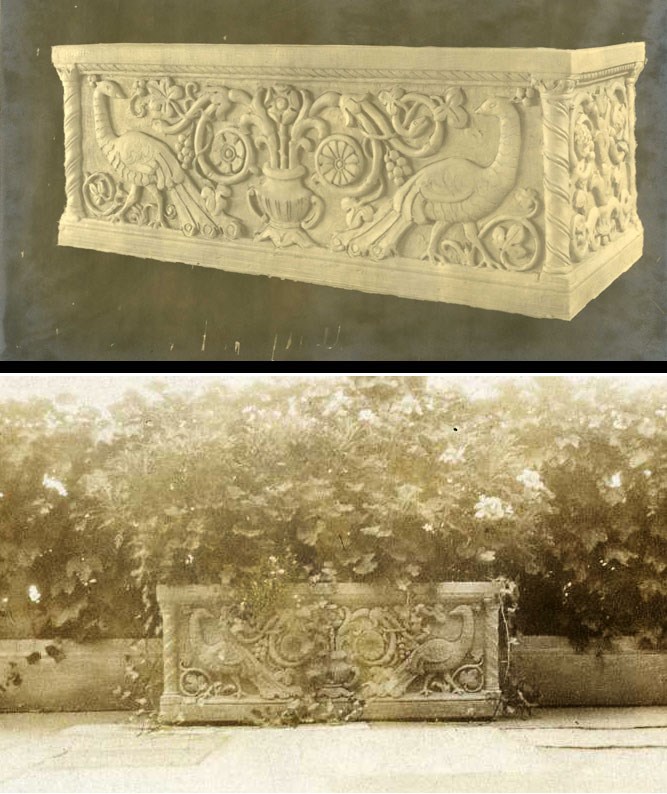
Top: Photo #5578-530; Bottom: Photo #5578-553, cropped, Olmsted Archives
Design Costs
We can learn more about what Selmer-Larsen's designs cost from the photo below. Clients were billed for both labor time and materials. More intricate projects would also be more expensive. In 1917 Selmer-Larsen charged $120 to make a mold for a bird bath. The client would also have to pick up an additional cost to have the models cast in material such as cement.
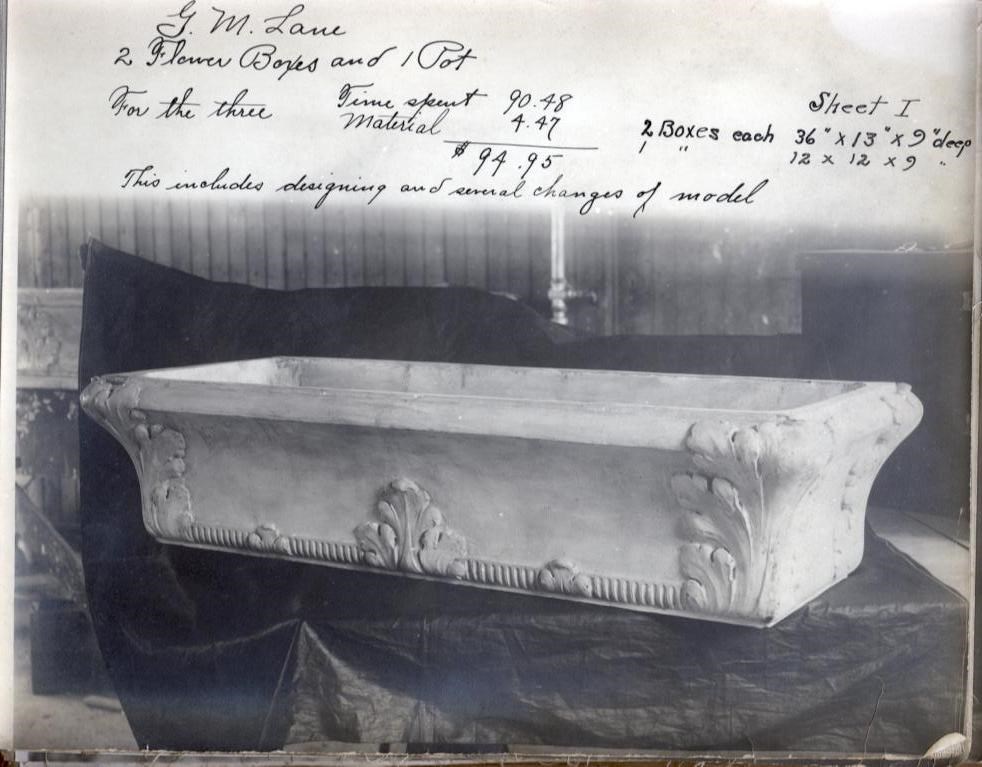
Job #00273, Olmsted Archives 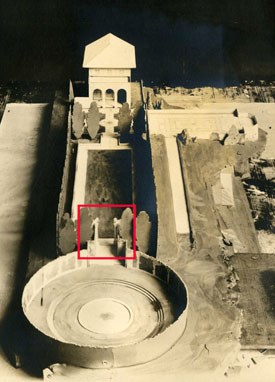
Photo #6218-13, edited, 1916, Olmsted Archives Sanderson EstateHenry Sanderson and his wife hired architects Hunt and Hunt to design an Italian-style villa he named "La Selva." To complement his Long Island, NY, home, Sanderson brought in Olmsted Brothers to plan the surrounding landscape. The Olmsteds created formal Italian gardens, corresponding to the home's architecture, and more natural areas. Mermaid and Merman To the left is a model that Selmer-Larsen made for the Sandersons showing Olmsted Brothers' plans for their formal garden. From the loggia, the Sandersons could look out over a stretch of lawn (called the tapis vert) and past two columns to a fountain in a circular garden. A merman and a mermaid would decorate these columns (framed by the red box). Selmer-Larsen began to design the merpeople after Olmsted Brothers completed their initial plans in 1916. He started by making a small, rough idea in clay. Below you see the merpeople coming to life. The models show how Selmer-Larsen gradually refined details from the small model on the left to the final version on the right. The final mermaid and merman have clearly defined features. Selmer-Larsen skillfully captured the strength of the merman, the graceful pose of the mermaid, and the movement of her hair. After what appears to have been a two-year process, the sculptures were ready to be cast. 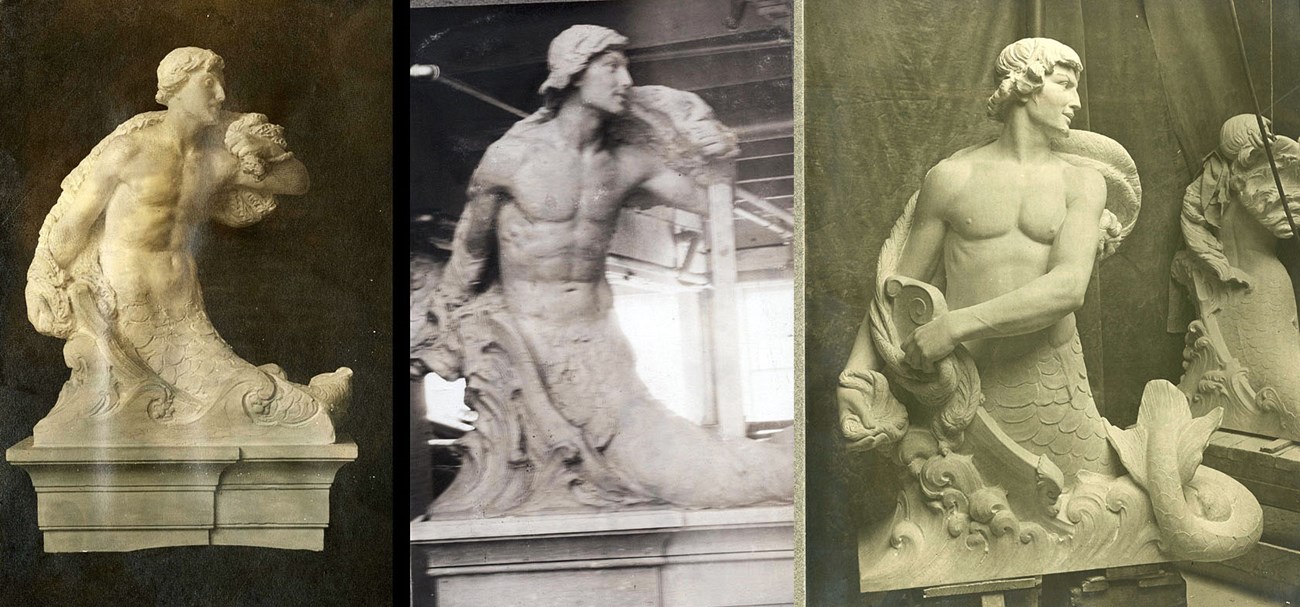
Left: Photo #6218-19, 1916; Middle: Photo #6218-96; Right: Photo #6218-172, 1918, Olmsted Archives 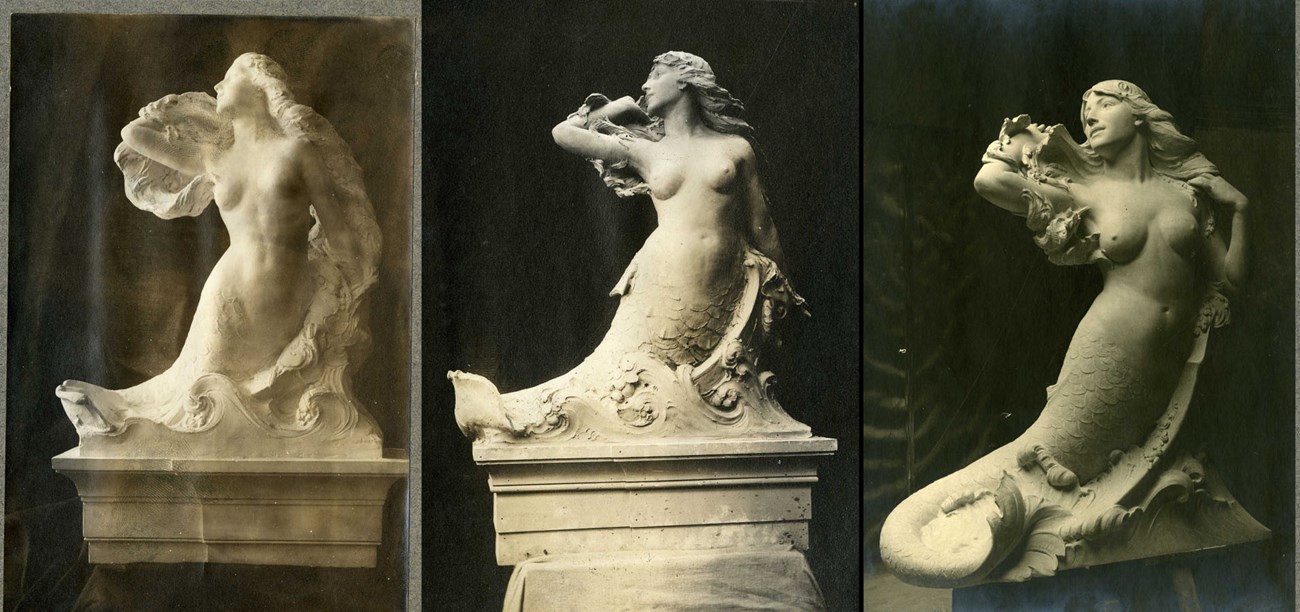
Left: Photo #6218-20, 1916; Middle: Photo #6218-91; Right: Photo #6218-176, 1918, Olmsted Archives 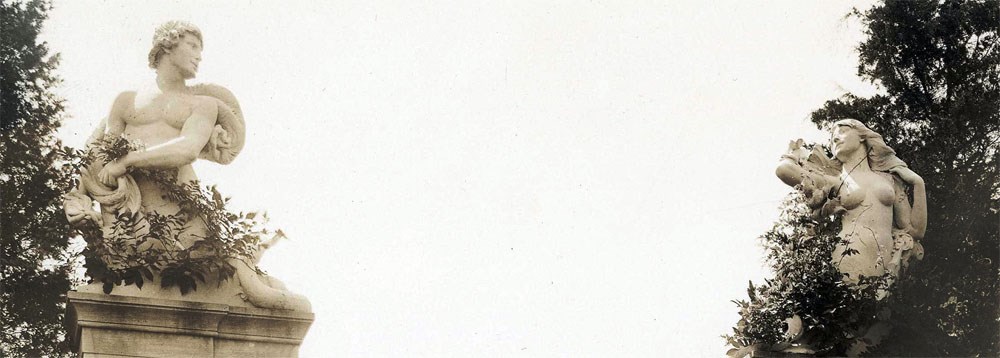
Job #06218, cropped, Olmsted Archives 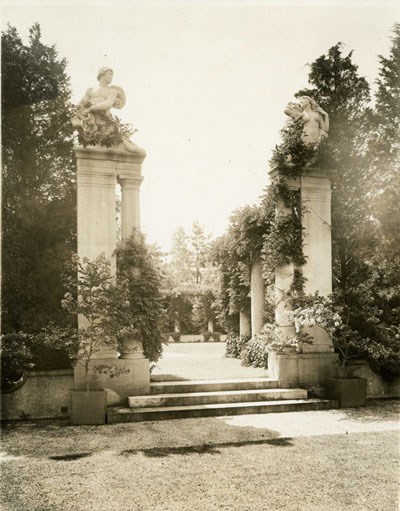
Job #06218, Olmsted Archives Three Graces Garden Panel Selmer-Larsen also sculpted a panel of the three graces for the Sandersons' flower garden. During the spring and summer of 1918 he worked on a model out of what appears to be clay. First he carved out the bodies of the graces, then he added the thin dresses over top and more details. Looking closely at a photo of the model reveals that he used pencil to draw out his ideas onto the clay. 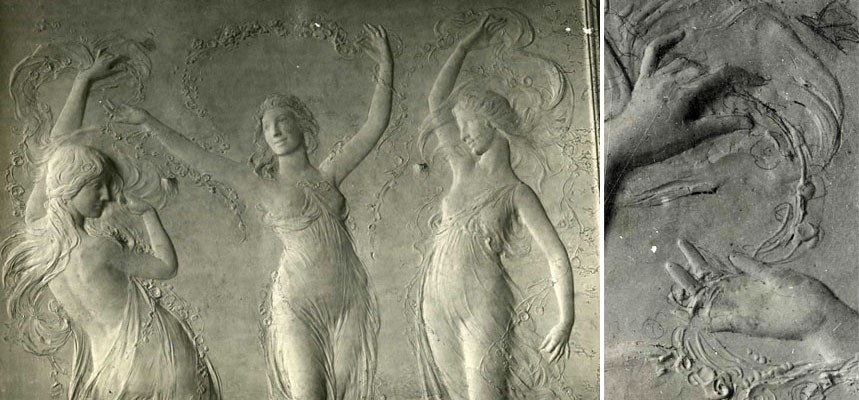
Photo #6218-164, cropped, 1918, Olmsted Archives
The next step was carving the panel out of stone. This was a laborious process requiring many hours of hammering a chisel into the stone, gradually adding finer details. Near the end Selmer-Larsen smoothed out the surface, most likely with a file-like tool. In the photo below, you can see his set up in the barn, and in the detail shot underneath, the chisel marks as he worked. The clay model stood as reference next to the stone slab.

Photo #6218-163, 1918, Olmsted Archives 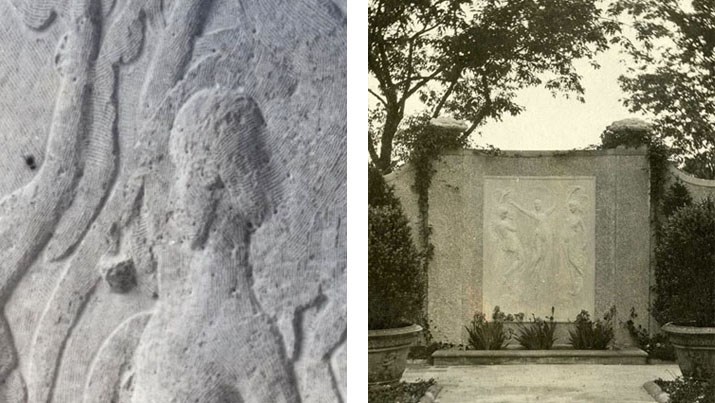
Right: Completed panel in place (Photo #6218-147, Olmsted Archives) What Materials did Selmer-Larsen use? 
Photo #6218-163 detail From purchase lists of the Olmsted firm, we know that the modeling department bought materials such as modeling clay, plastilina (a clay with a wax and oil base), plaster, concrete, hammers, engraving tools, and chisels.There were also two ovens in the barn where he worked that may have been used to bake clay. On the left is a close-up from the above photo in the barn. It shows some of Selmer-Larsen's tools. |
Last updated: March 6, 2024
